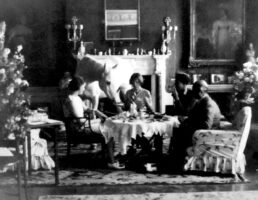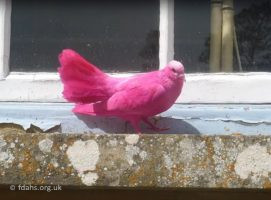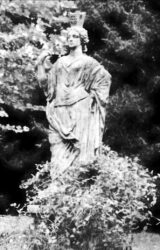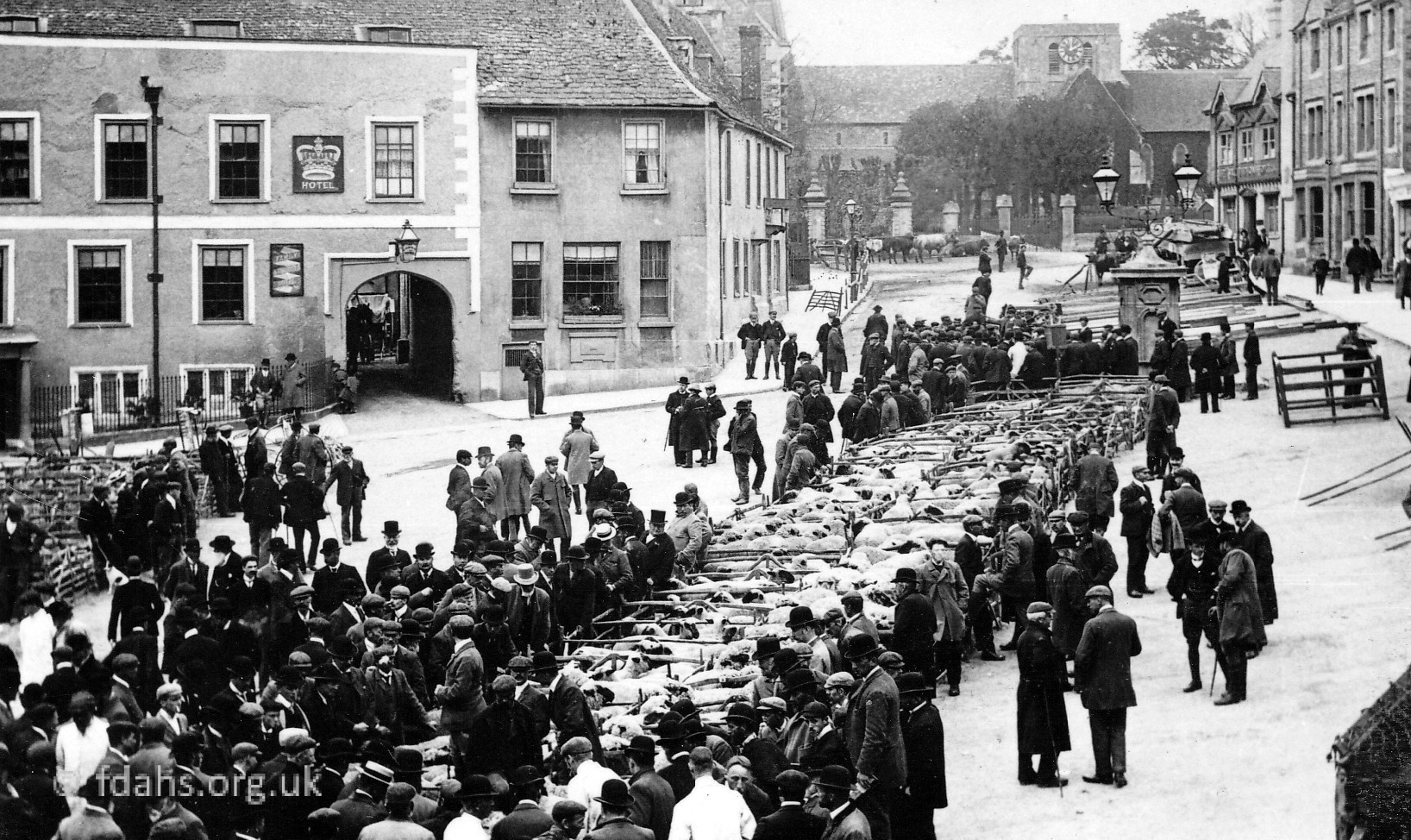
Faringdon House lies to the north of the parish church on top of the escarpment overlooking the Thames valley. The house seen today is not the original building, the previous one was completely destroyed by fire in the late 1760s. A manor house is known to have been on the site since at least 1174.
Faringdon House is now a Grade I Listed building and many of the features/structures in the grounds are Grade II listed. There have been many notable owners, Lord Berners among them. (Faringdon House was mostly the home of the ‘Lords of the Manor of Faringdon’ and not the home of ‘Lord Faringdon’, who lives, as did his two predecessors at Buscot House.)
Sir Henry Unton (c.1557-1596)
 The drawing shows the previous Faringdon House, a rambling Elizabethan mansion between the site of the present building and the church. It was built in the 1590s for Sir Henry Unton. He was a courtier at the court of Queen Elizabeth. He fought against the Spanish in the Netherlands earning his knighthood at the battle of Zutphen in 1586. He became the Ambassador to France in 1591.
The drawing shows the previous Faringdon House, a rambling Elizabethan mansion between the site of the present building and the church. It was built in the 1590s for Sir Henry Unton. He was a courtier at the court of Queen Elizabeth. He fought against the Spanish in the Netherlands earning his knighthood at the battle of Zutphen in 1586. He became the Ambassador to France in 1591.
 Sir Henry gave the Portwell to the town. It was then the town’s only piped water supply. He also left money to be used in charitable causes for the relief of impotent and poor people of the town. Sir Henry Unton’s charity, founded in 1591, consisted of land property from which the income paid for apprenticing poor children and the distribution of blankets to the poor.8 [‘Blankets for the poor’ continued well into the 20th century – the Westbrook blanket charity, founded 1859, did something similar and in 1907 forty-four blankets were distributed among the poor of the Westbrook district.8 Blankets were also given to the poor farm workers moving in to the new Marlborough Gardens housing estate after WWII.]
Sir Henry gave the Portwell to the town. It was then the town’s only piped water supply. He also left money to be used in charitable causes for the relief of impotent and poor people of the town. Sir Henry Unton’s charity, founded in 1591, consisted of land property from which the income paid for apprenticing poor children and the distribution of blankets to the poor.8 [‘Blankets for the poor’ continued well into the 20th century – the Westbrook blanket charity, founded 1859, did something similar and in 1907 forty-four blankets were distributed among the poor of the Westbrook district.8 Blankets were also given to the poor farm workers moving in to the new Marlborough Gardens housing estate after WWII.]
On his death, the house passed to his son-in-law, John Wentworth.
Sir Robert Pye (1585-1662)
Ownership was passed into six generations of the Pye family when it was purchased by Sir Robert Pye in 1622 before his death that year.
The house was twice under siege during the Civil War of 1642-1646, being a Royal Garrison and one of the last places to hold out for the king. In 1646 fighting was so fierce that the church, in a position between the Royalists in Faringdon House and the Parliamentarian guns to the east of the town, lost its steeple, the top of the tower and part of the south aisle. Two canon balls were found in the debris of the belfry when the bells were re-cast.
More about the Pye family? … Faringdon Community Website.
Sir Henry James Pye (1745 – 1813)
 The old house burnt down soon after Sir Henry James Pye inherited it from his father Henry (Robert’s great grandson) in 1766. Sir Henry had the current house built between 1770-85 slightly to the north of the old building. Much of the material from the original house was used in the new building and traces of charring can be seen on the underside of the oak flooring. By the time the building was finished he had to sell it and the estate due to his and his father’s debts.
The old house burnt down soon after Sir Henry James Pye inherited it from his father Henry (Robert’s great grandson) in 1766. Sir Henry had the current house built between 1770-85 slightly to the north of the old building. Much of the material from the original house was used in the new building and traces of charring can be seen on the underside of the oak flooring. By the time the building was finished he had to sell it and the estate due to his and his father’s debts.
Following his political career as the Member of Parliament for Berkshire 1784-90, he was appointed poet laureate to George III. He then distinguished himself as being the worst ever poet laureate. The nursery rhyme ‘Sing a Song of Sixpence’ was written as a skit against him. More about him? … Faringdon Community Website.
 During the building of the new house, he* had the Radcot Road diverted by an Act of Parliament to its current position further along Church Street. It used to start at the current entrance gates beside the church, but the road then passed too close to the house. At that time it was an important trade route and a perfectly straight road from the Market Place up Church Street to Radcot Bridge. (* this is from the memory of a reading and may have been done by an earlier Pye.)
During the building of the new house, he* had the Radcot Road diverted by an Act of Parliament to its current position further along Church Street. It used to start at the current entrance gates beside the church, but the road then passed too close to the house. At that time it was an important trade route and a perfectly straight road from the Market Place up Church Street to Radcot Bridge. (* this is from the memory of a reading and may have been done by an earlier Pye.)
Lord Daniel Bennett (1760 – 1826)
 Daniel Bennett (photo) purchased the house in 1818 thus taking the title of Lord of the Manor of Faringdon. He owned and ran a very successful shipping company. Following his death, the estate and title were inherited by his son William Bennett (1790 – 1844) and then his son Daniel Bennett (1823 – 1887). Amongst many things, grandson Daniel helped the setting up of the Faringdon Railway Company and the Faringdon Rifles Volunteers around 1860. He did not at first live in the house, but let it and occupied Sudbury House, which his father had acquired as a dower house. Daniel’s only daughter, Marianna Katherine Bennett finally inherited the house and remained living there until she died unmarried in 1919.10 Bennett Road in Faringdon commemorates the family name. More about them? … Faringdon Community Website.
Daniel Bennett (photo) purchased the house in 1818 thus taking the title of Lord of the Manor of Faringdon. He owned and ran a very successful shipping company. Following his death, the estate and title were inherited by his son William Bennett (1790 – 1844) and then his son Daniel Bennett (1823 – 1887). Amongst many things, grandson Daniel helped the setting up of the Faringdon Railway Company and the Faringdon Rifles Volunteers around 1860. He did not at first live in the house, but let it and occupied Sudbury House, which his father had acquired as a dower house. Daniel’s only daughter, Marianna Katherine Bennett finally inherited the house and remained living there until she died unmarried in 1919.10 Bennett Road in Faringdon commemorates the family name. More about them? … Faringdon Community Website.
Lord Berners
 Lord Berners, Gerald Hugh Tyrwhitt-Wilson (1883-1950) inherited his title and baronetcy on the death of his uncle Sir Raymond, fourth baronet, in 1918. He sold his inherited estates as quickly as possible and was able to negotiate the purchase of Faringdon House and Estate. His mother and step father, William Ward Bennett, were already occupying the house and they continued to live there until their deaths in 1931.
Lord Berners, Gerald Hugh Tyrwhitt-Wilson (1883-1950) inherited his title and baronetcy on the death of his uncle Sir Raymond, fourth baronet, in 1918. He sold his inherited estates as quickly as possible and was able to negotiate the purchase of Faringdon House and Estate. His mother and step father, William Ward Bennett, were already occupying the house and they continued to live there until their deaths in 1931.

Lord Berners lived in the house with his young (by 27 years) companion, Robert Heber-Percy, known as the ‘Mad Boy’. Their home became an exotic playground for the great and the good, the famous and infamous: Salvador Dalí, Aldous Huxley, HG Wells, Stravinsky, Evelyn Waugh, John Betjeman, Elsa Schiaparelli, and Nancy Mitford. Nancy immortalised Berners in her novel ‘The Pursuit of Love’ as the whimsical Lord Merlin.

In 1940, a group of WWII evacuees visited Faringdon House when a meet of the Old Berks Hunt was taking place. Lord Berners is on the steps with Mrs Penelope Betjeman and her white horse ‘Moti’. In the foreground are the evacuee schoolchildren from London with their teacher Mr Smith.
Lord Berners was a world-class composer, poet, playwright and a rich eccentric bachelor. He worked at a piano adorned with a beer mug that played the National Anthem whenever it was lifted. He installed a clavichord in his Rolls-Royce so he could compose on the move, and he drove around the lanes wearing a pig’s head mask to frighten the locals.
 If you wander around the town and look up in the right places you might see some of the eccentric signage that he was responsible for. It was all said to be that Lord Berners was “having a bit of fun at the expense of pompous people”. The photo shows one above what is currently Floyd’s Grill in London Street – if you look very closely you will be able to read what it says.
If you wander around the town and look up in the right places you might see some of the eccentric signage that he was responsible for. It was all said to be that Lord Berners was “having a bit of fun at the expense of pompous people”. The photo shows one above what is currently Floyd’s Grill in London Street – if you look very closely you will be able to read what it says.
 He is perhaps most well-known today for building the Folly Tower in the mid 1930s. On the door to the tower was a sign that read ‘Members of the public committing suicide from this tower do so at their own risk‘.
He is perhaps most well-known today for building the Folly Tower in the mid 1930s. On the door to the tower was a sign that read ‘Members of the public committing suicide from this tower do so at their own risk‘.
 Lord Berners is also well remembered for dyeing his pigeons in vibrant colours, using natural dyes that did them no harm. The pigeon-colouring has become a tradition that continues today with the new owners and the evidence can occasionally be seen flying around the town. Don Pargeter, who worked for Robert Heber-Percy, and occasionally seen in the Folly Inn with stained arms, is said to have commented that they actually quite liked it, as it knocked off all the parasites. There is another photo near the bottom of this page showing a few more of the different colours used.
Lord Berners is also well remembered for dyeing his pigeons in vibrant colours, using natural dyes that did them no harm. The pigeon-colouring has become a tradition that continues today with the new owners and the evidence can occasionally be seen flying around the town. Don Pargeter, who worked for Robert Heber-Percy, and occasionally seen in the Folly Inn with stained arms, is said to have commented that they actually quite liked it, as it knocked off all the parasites. There is another photo near the bottom of this page showing a few more of the different colours used.
More about Lord Berners? … Faringdon Community Website.
Robert Heber-Percy
 Robert Vernon Heber-Percy (1911-1987) inherited the property (but not the title) on the death of Lord Berners in 1950. He was 27 years younger than Lord Berners and said to be extremely handsome by men and women alike. He was also said to be a charming and generous local eccentric, known locally as the ‘Mad Boy’. He worked with his estate workers on the upkeep of the grounds, had the swimming pool built near the house (photo below), started the town fireworks display, and set up the Faringdon Folly Tower Trust. More about him? … Faringdon Community Website.
Robert Vernon Heber-Percy (1911-1987) inherited the property (but not the title) on the death of Lord Berners in 1950. He was 27 years younger than Lord Berners and said to be extremely handsome by men and women alike. He was also said to be a charming and generous local eccentric, known locally as the ‘Mad Boy’. He worked with his estate workers on the upkeep of the grounds, had the swimming pool built near the house (photo below), started the town fireworks display, and set up the Faringdon Folly Tower Trust. More about him? … Faringdon Community Website.
The Egypt Statue


 The statue that can be seen watching over the Radcot Road, was once in the gardens of Crystal Palace. In 1957 it was one of two statues bought at auction and placed in the grounds of Faringdon House by Robert Heber-Percy. This statue depicts the shrouded figure of ‘Africa’, leaning on what appears to be the head of the Sphinx; Africa embracing Egypt.
The statue that can be seen watching over the Radcot Road, was once in the gardens of Crystal Palace. In 1957 it was one of two statues bought at auction and placed in the grounds of Faringdon House by Robert Heber-Percy. This statue depicts the shrouded figure of ‘Africa’, leaning on what appears to be the head of the Sphinx; Africa embracing Egypt.
 The Great Exhibition at the ‘second’ Crystal Palace opened in 1854 with a series of 26 statues running along the entire front of the new Palace. The statues represented various countries and cities around the world. One of these, Egypt, was sculpted by the Italian-born French sculptor Baron Carlo Marochetti (1805-1867). Another, by Antoine Etex (also French), represents Marseilles (photo left).6 Although another source says that it represents ‘Asia’. 7
The Great Exhibition at the ‘second’ Crystal Palace opened in 1854 with a series of 26 statues running along the entire front of the new Palace. The statues represented various countries and cities around the world. One of these, Egypt, was sculpted by the Italian-born French sculptor Baron Carlo Marochetti (1805-1867). Another, by Antoine Etex (also French), represents Marseilles (photo left).6 Although another source says that it represents ‘Asia’. 7
The palace was destroyed by fire in 1936 and the statues and vases from the terraces and grounds were sold by public auction in 1957. It was here that Robert Heber-Percy snapped up a couple of bargains, and bought these two figures for £1.10s.0d each. Both are now in the grounds of Faringdon House. It was presumably his idea to place one on the top of the old WWII pillbox to overlook the Radcot Road. 6
There is also a story that these statues came from the old Houses of Parliament which had five of them to dispose of. Each of the statues is said to have depicted one of the five continents, these ones being Africa and Asia. This was when the medieval royal palace, then used as the home of the British parliament, was largely destroyed by fire on 16 October 1834. If true, then perhaps those 5 statues were actually first moved from there to the Crystal Palace twenty years later.
Views of House & Gardens










Owners of Faringdon House
1590s Sir Henry Unton (c.1557-1596), the English Ambassador to France.
1597 John Wentworth, who was married to Cecily Unton.
1622 sold to Sir Robert Pye (1585-1662), but Sir Henry’s widow, Dame Dorothy continued to live there until her death in 1634.
1662 Robert Pye (son of Sir Robert)
1701 Edmund Pye (son of Robert)
1705 Henry Pye (son of Edmund)
1740 Henry Pye (son of Henry)
1766 Sir Henry James Pye (1745-1813), poet laureate to George III. Built the new house during 1770-85.
1785 sold to William Hallett (1764-1842), grandson of the famous London cabinet maker. A gambler who lost money in business transactions, and worked his way through his fortune by 1830.
1818 sold to Daniel Bennet (1760-1826), inherited by son William Bennett ( 1790-1844), his son Daniel Bennet (1823-1887), then Daniel’s only daughter, Marianna Katherine Bennett.
1918 sold to Gerald Hugh Tyrwhitt-Wilson (1883-1950), 14th Baron Berners. But his mother and step-father William Ward Bennett lived here until 1931, when they both died.
1950 Robert Heber-Percy (1911-1987), Lord Berners’ companion. Built the swimming pool, started the town fireworks display, and set up the Faringdon Folly Tower Trust.
1987 Sofka Zinovieff, writer and the granddaughter of Heber-Percy and Jennifer Fry. Her parents were Peter Zinovieff and Victoria Gala Heber-Percy. Sofka inherited the house but did not move in straight away. Sofka’s brother Leo and Annabelle, his wife, lived in the house for a few years then it was rented out until 2013/14 when Sofka moved in. During this time much of the contents were sent to auction, presumably to cover the inevitable costs of taxes and repairs.
2018 Charles Crossley-Cooke purchased the property for £11.5m. Since then the house has been completely refurbished.
Further Reading: A full list of owners/occupiers of Faringdon House 1590-2018 and the earlier Manor since 1174 can be found on the Faringdon Community Website.
References:
- The Changing Faces of Faringdon and Surrounding Villages – Book 1 p44. By Rosemary Church, Jim Brown, Millie Bryan and Beryl Newman. Robert Boyd Publications 1999.
- Photographs 1994/95 by Brian Brady
- House & Garden – https://www.houseandgarden.co.uk/gallery/sofka-zinovieff-faringdon-house
- Royal Berkshire History – https://www.berkshirehistory.com/castles/faringdon_house.html
- Faringdon Community website – Robert Heber-Percy – https://www.faringdon.org/heber-percy-more-info.html
- Egypt Statue – Radcot Road. Faringdon House Grounds by Sjoerd Vogt.
- Curiosities of Oxfordshire – A County Guide to the Unusual by Edward Gill, p22. S.B.Publications 1995.
- British History Online – Parishes: Great Faringdon – https://www.british-history.ac.uk/vch/berks/vol4/pp489-49
- Directory & Gazetteer of Oxon, Berks & Bucks – Dutton, Allen & Co 1863.
- Landed families of Britain and Ireland – https://landedfamilies.blogspot.com/2023/10/561-bennett-of-faringdon-house.html
Researched by Ian Lee, November 2019.
